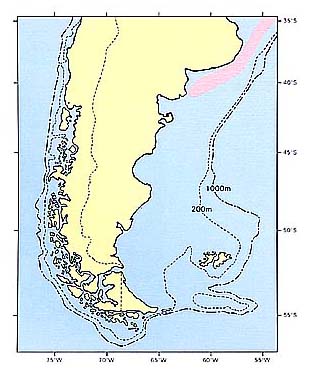ニベ科
ニベ科(Sciaenidae)

82 クロシママルニベ(Kuroshima-marunibe)
Umbrina canosai Berg, 1895
Pargo blanco (Arg., Urg.); Aastanha (Br.)
特 徴:
背鰭11棘,21~25軟条,臀鰭2棘,7~8軟条,胸鰭18軟条,腹鰭1棘,5軟条,側線鱗数48,鰓耙数8+12=20~24。体長に対する体高の割合は33.0%,頭長は30.1%,眼径は5.3%,両眼間隔は8.3%,吻長は10.2%,上顎長は10.9%,尾柄高は10.5%,胸鰭長は22.1%,腹鰭長は17.7%,臀鰭基底長は11.5%,背鰭前長は38.4%。体は長楕円形で側扁する。背鰭は深い欠刻を有するか,またはわずかに分離する。軟条部の最前部に小さな1棘がある。尾鰭後縁はわずかに湾入する。吻は円鈍。口は小さく下位で,ほぼ水平。両顎歯は絨毛状で,歯帯を形成する。前鰓蓋骨縁辺は鋸歯状。下顎先端下面に1本の髭があり,その両側に2対の大きな感覚孔を開く。吻の先端に8個の孔がある。鱗は櫛鱗で,側線は尾鰭の先端にまで達する。鰓耙は短い。鰾は成魚ではよく発達する。体側上部に多数の細い暗色の斜縞がある。胸鰭基部に暗色斑はない。
分 布:
ブラジル南部リオデジャネイロ沖(Cabo de São Tom'e, 22°35′S)からアルゼンチン北部のボナレンシス海域(40°S)付近までの水深10mから200m,特に100m付近に多く分布する(Menezes and Figueiredo, 1980)。
備 考:
産業上重要な中型のニベで,体長約35cm。ブラジルには近縁のU. coroidesが分布するが,背鰭及び臀鰭軟条数,鰓耙数で異なる。アルゼンチン海域では本属は1種のみ。
(稲田伊史)
Material examined:
1 from Argentina (262.5 mm SL), FSFL EM 507.
Description:
D ⅩⅠ, 21-25; A Ⅱ, 7-8; P1 18; P2 Ⅰ, 5; LLS 48; GR 8+12=20-24. HL 30.1% of SL; ED 5.3; BO 33.0; SN 10.2; IO 8.3; UJ 10.9; CP 10.5; P1L 22.1; P2L 17.7; A base L 11.5; PreD 38.4.
Body oblong, compressed. Dorsal fin with a deep notch or almost divided in two; a short spine in front of soft dorsal. Posterior margin of caudal fin slightly concave. Tip of snout blunt. Mouth small and inferior, nearly horizontal. Teeth on both jaws villiform, forming bands. Preopercular margin finely serrated. A stout, rigid barbel at tip of lower jaw, its tip rounded; two pairs of large mental pores on ventral side of head laterally. Tip of snout with 8 pores. Scales ctenoid. Lateral line extending to posterior margin of caudal fin. Gill-rakers short. Swim-bladder well developed in adults. Upper part of body with many dark longitudinal strips; no well defined dark spot at bases of pectoral fins.
Distribution:
From southeast of Brazil (Cabo de São Tomé, RJ, 22°35′S) to northern Argentina (Bonaerensis area, 40°S) at depths of 10 m to 100 m. Especially abundant at depths of about 100 m.
Remarks:
Commercially important middle-sized drum. Body length about 35cm SL. Closely related species, U. coroides, is distributed off Brazil, but differs from this species by number of dorsal and anal soft rays, 13-15 conspicuous lateral stripes (20-24 stripes in U. canosi) and gill-rakers (Menezes and Figueiredo, 1980). There are 3 other species of Umbrina, U. broussonetii Cuvier, 1830, U. coroides Cuvier, 1830 and U. milliae Miller, 1971 in the western Atlantic (Chao, 1978).
(Tadashi INADA)

Distribution of Umbrina canosai in Patagonia.